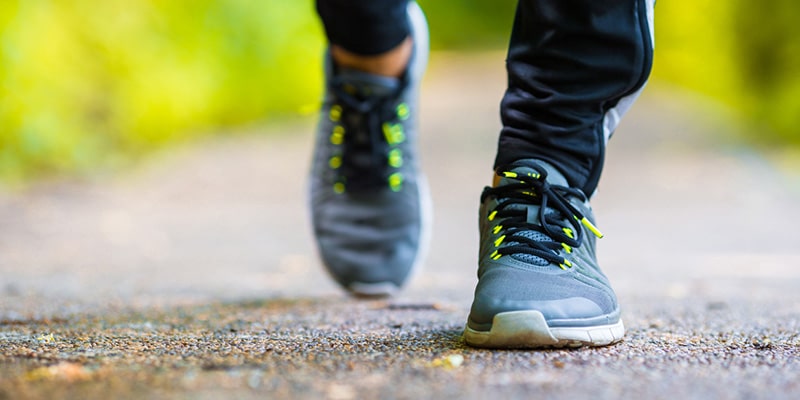When in Doubt, Take a Walk

Did you know that sitting for more than 8 hours a day is associated with a 90% increased risk of type 2 diabetes as well as increased likelihood of developing heart disease and cancer?
With serious health consequences such as these, we’ve gathered all the information we could find on how you can get out of your chair and start moving around. If you’re a fitness newbie, don’t worry, this article is going to share with you a form of exercise that almost everyone can do: walking.
Some people might associate walking for fitness with older people who cannot perform high intensity workouts anymore. However, no matter if you are young or old, you can benefit from incorporating walking into your performance plan.
Why take a walk?
Staying in shape doesn’t need to be complicated. Something as simple as walking around the block on a daily basis can help you live a healthier life. You may be surprised by all of the benefits walking can have. For example, taking a brisk 30 minute walk every day can help you:
- Maintain a healthy weight
- Lower your risk for obesity
- Reduce your risk of developing type II diabetes
- Strengthen your muscles
- Decrease your risk for osteoporosis by strengthening bones
- Improve your balance and coordination
- Lower stress levels
- Reduce the risk of coronary heart disease
- Improve your blood pressure
- Improve your blood glucose levels and lipid profile
According to Dr. Joseph Mercola, researchers have found that engaging in a brisk walk of moderate intensity (at least 20 to 25 minutes) on a daily basis could have anti-aging benefits that add an additional three to seven years to your life! The research supporting this statistic, presented at the European Society of Cardiology (ESC) Congress, followed 69 people between the ages of 30 and 60. An anti-aging process was triggered in those who participated in daily moderate exercise, such as a brisk walk or jog, high-intensity interval training (HIIT), and strength training. The data in this study lead researchers to recommend at least a 20-minute daily walk to reap these benefits.
Perfect your form

To enjoy all of these walking benefits, you’ll need to perfect your form. Tina Vindum, author of Tina Vindum’s Outdoor Fitness, shares with Fitness Magazine her checklist for having the perfect walking form that she calls SCuLPT:
Shoulders:
Keep your shoulders drawn back to open up your chest while you’re walking.
Chin:
Don’t let your chin jut forward. Try to make sure it’s parallel to the ground.
Lifted:
Stand tall and lift your ribs away from your hips.
Pelvis:
Tip your pelvis forward and back as far as it can go, then settle in the middle to find a healthy neutral position for your spine.
Transverse:
To feel your transverse abdominal muscles, place your hands on your hips and draw them in and up. The transverse muscles are underneath your fingertips. Keep this ab area firm as your breathe during a walk.
Pace Yourself
If you’re just getting started with walking for fitness, keep your pace slow and steady at first, then gradually increase the intensity and distance of your walks. Much of the research that demonstrates the health benefits of walking suggests that 10,000 steps per day is the number to aim for. While 10,000 steps may seem like a lot, it is actually just under 5 miles for the average person.
While you’re creating a habit of daily walking, try giving barefoot walking a try. Dr. Joseph Mercola explains that, “In addition to the physical benefits of walking, walking barefoot allows your body to absorb free electrons from the Earth through the soles of your feet, a practice known as grounding.”
The electrons Dr. Mercola referred to have powerful antioxidant effects that protect the body from inflammation and numerous other health conditions, such as sleep disturbances, asthma and other respiratory conditions, chronic muscle and joint pain, and many others. Plus, we could all use another excuse to walk on the beach, right?
Add walking to your regular routine

Sitting on the couch to “chill” after a long day of work is one of the most relaxing things to do, right? While this is true for many people, prolonged sitting comes with deleterious health consequences, such as a greater risk for cardiovascular disease, type II diabetes, and even cancer (breast, colon, colorectal, endometrial, and epithelial ovarian). (BMJ, 2015)
The need to move away from a sedentary lifestyle is clear, but how can you add walking to your regular routine when you are busy and exhausted?
One way to make walking a habit is to set a personal challenge. Nowadays, there seems to be an infinite number of apps and fitness trackers that will log your activity throughout the day. These apps can be helpful to track your progress of how many steps you take per day.
Stuck behind a desk all day? There are ways you can add walking to your regular routine, too! Try simple things like taking the stairs instead of the elevator or using your lunch break to take a walk. Or create challenges amongst your colleagues to see who can log the most steps during a set period of time. Research from Workplace Challenge reveals that friendly competition is a great motivator to get active.
When in doubt, take a walk
There’s no doubt about it: walking can help you stay fit and reduce your risk of serious diseases, such as coronary heart disease, type II diabetes, and even cancer. Of course, other forms of exercise such as strength training and more intense forms of cardio are going to get you more bang for your buck in terms of weight loss and building muscle. But if you aren’t at the point where you can perform those types of exercises, walking is an effective way to stay fit and healthy.


